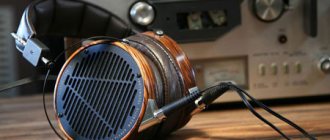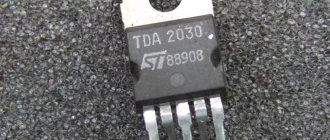Prince of Denmark
Integrated amplifier Gryphon Diablo 300 Price - RUB 985,000.
Gryphon audio equipment belongs to the elite of High End Audio, which is quite eloquently indicated by the attitude of experts and audiophiles towards products marked with the sign of the ancient “birdbird”. Introduced about ten years ago, the Gryphon Diablo is probably one of the most outstanding integrated amplifiers in the history of this type of amplifier. This spring in Munich, the Danish company showed a new generation of the model, called Diablo 300.
The impression of extraordinary solidity, fundamentality and proximity of constructive and sound perfection produced by Gryphon equipment is in harmony with the names of the models, borrowed mainly from ancient Greek myths, as well as from medieval European history (Pendragon, father of King Arthur), and not only European (Mikado) ... A completely natural semantic parallel arises: the classics of high-end audio are cultural classics. In this sense, Diablo 300 is the flesh of Gryphon. There is a DAC with the same name in the Gryphon catalog. This time we are interested in the integrated amplifier of the same name.
The equipment of this reputable brand, as always, is highly informative. Below is a summary of the content of Diablo 300, constructive and musical. The new product provides higher output power compared to its predecessor: 2 x 300, 600 and 950 W into 8, 4 or 2 ohms compared to 250, 500 and 800 ohms into the same load for Diablo. The inclusion of a power parameter in the specifications when operating a load with a resistance of 2 Ohms indicates the amplifier’s readiness to drive the most complex reactive load, the impedance of which can drop almost to the level of a short circuit. By the way, the performance of the amplifier is reliably protected by an intelligent non-contact protection system that monitors the operating condition and instantly responds to problems that arise. Multi-section radiators are responsible for thermal stability, evoking an association with the plumage of a griffin.
Conceptually and technologically, the Gryphon Diablo 300 is close to the Pandora preamplifier and the Mephisto power amplifier. The design basis of the Diablo 300 is a full dual mono circuit with a new high-speed discrete single-ended input stage operating in class A. Behind the definition of “high-speed” is such a fundamental parameter as a high slew rate of the output voltage, and, as a result, extraordinary ability practice the transient response, which is critical for the correct presentation of music. In accordance with the ideology of Gryphon and High End in general, Danish engineers designed an amplifier with an ultra-short signal path without negative feedback.
The remote control is an extraordinary work of design art. The product in the form of a laconic rectangular block, standing on a corner and two legs of an original V-shaped support, is extremely convenient and simply beautiful. The model uses high-quality - manufactured in accordance with military industry standards - two-layer and four-layer printed circuit boards with copper traces more than 0.1 mm thick. All electronics, including audiophile-grade elements, are mounted only on printed circuit boards, right down to the connectors - wall-mounted mounting is not used in the amplifier. Gryphon Diablo 300 cascades are powered separately. Local shunt stabilizers implemented in the power supply with parallel connection of regulatory elements effectively maintain a low noise level (Diablo used low voltage sources with zener diodes). Vacuum treatment of the core and windings of the Holmgren toroidal transformer, the main element of the Gryphon Diablo 300 power supply circuit, is also aimed at noise suppression. The energy of the power source is also supported by the capacity of the filter capacitors 2 x 68,000 mF; Here only polypropylene coupling capacitors work in parallel with high-quality electrolytic ones.
The 43-step microprocessor-controlled balanced volume control is assembled using a minimum of ultra-precision elements. Thus, no more than two resistors are involved in setting any output signal value. The control is similar to that implemented in the Gryphon Pandora preamplifier.
The Diablo 300 has a wide range of switching and functionality. As noted above, all connectors are installed on a printed circuit board to avoid additional wiring. Of the five line inputs, two are balanced, on Neutrik connectors with gold-plated contact surfaces. There are also two unbalanced outputs on RCA connectors. The “tulips” use Teflon insulation. Gryphon engineers have provided the amplifier with a phono stage board or a DAC module, offered as options. The large Gryphon screw acoustic terminals look impressive, suitable for connecting cables of any cross-section and terminated in any way.
Truly amazing, truly luxurious sounding. One of its most valuable qualities is its combination of unbiased accuracy with artistry. In other words, the Gryphon Diablo 300 is true to both the letter and spirit of the music it produces.
The Gryphon Diablo 300 features a programmable fixed-level AV input for connecting to a cinema processor, a full-range subwoofer output (low-pass set by an external filter), an external IR receiver signal input, and a 12-volt control trigger input and output for centralized control. food. The component allows you to configure automatic matching of input levels to protect the hearing of the owner and equipment when switching between sources. It is possible to set fixed minimum (initial) and maximum volume levels.
The standby power consumption of the amplifier according to the passport is less than 0.5 W; after switching on, if there is no signal at the input, this parameter increases to 200 W, and during operation, the component can require up to 1900 W of power from the electrical network. After activating the Gryphon Diablo 300 using the switch on the bottom (near the front bottom edge of the device) and the Standby/Power button, the mirror-black acrylic surface of the touch display comes to life. When turned on, the device prepares for operation by initiating input. It is possible to change the brightness of the display (four positions) and completely turn off the display. All adjustments are made using both the touch keys on the device and the remote control. The latter is an extraordinary work of design art. The remote control in the form of a laconic rectangular block (square in cross section), standing on a corner and two legs of the original V-shaped support, is extremely easy to use and simply beautiful.
The impression of the appearance of the Gryphon Diablo 300 is difficult to express in words. On the one hand, everything here has obviously been polished with skillful, even sophisticated design ideas, tending toward rigor and even asceticism. On the other hand, the well-known principle of form follows function applies. The harmonious fusion of these two sides is one of the hallmarks of Danish design in general, and Gryphon in particular. The quality of the work performed? Designed and made in Denmark – that says it all. When removing the apparatus from the box and placing it on the laboratory stand, the first thought (after the “weight is taken” and you can exhale) is about the earth’s gravity, which is so annoying at times; the second is about the heavy entablature of the Athenian Parthenon...
The sound of Gryphon Diablo 300... It can be described briefly, with utmost responsibility for the correspondence of words to musical and acoustic reality, with the following formulas: perfect control and balancing of all sound components; authenticity and highest precision without sterility; bringing sound architecture of any complexity, tempo-rhythmic, dynamic, spatial (stage plot) and color components to a musical optimum... This is truly amazing, truly luxurious sound. One of its most valuable properties is the combination of impartial, almost instrumental rigor with artistry and lively musical plasticity. In other words, the Gryphon Diablo 300 is true to both the letter and spirit of the music it produces. The author of these words, perhaps, would not have been able to find any roughness in the sound of the 300th... even if the Motherland had demanded it...
Describing the sound of its predecessor Diablo, and, obviously, playing on the name of the amplifier, journalists often resorted to the definitions of “divine”, “angelic” (the contrast between a heavenly angel and a fallen angel), etc. One way or another, all these delights are addressed to the Diablo 300 would not seem excessive or inappropriate. People have a certain tendency to explain what strikes them to the extreme as the intervention of evil spirits (this was, for example, the reaction to the art of Paganini) ... However, it is worth refraining from describing the sound of Diablo 300 as “diabolically good” ...
It should be noted that all the above-mentioned qualities manifested themselves when testing the amplifier in a system, most of the components of which are clearly not equal to the “griffin” in class. Nevertheless... It is not difficult to imagine what the dynamics of sound quality will be like when included in the path along with the Gryphon Diablo 300 of its classmates.
Gryphon Diablo 300
In designing the Diablo 300, the Gryphon engineering team drew on concepts and technological discoveries made during the development of Gryphon's renowned Pandora preamplifier and Mephisto power amplifier. The fully balanced volume control topology takes full advantage of the two balanced inputs. Unlike most solid-state volume controls, which include dozens of resistors in the signal path, the Diablo 300 uses only 2 resistors for any volume level. This gives extraordinary transparency, precision and incredible dynamics. The Diablo 300's extremely wide frequency response extends from 0.5 Hz to 350 kHz, and its high power output of 300 watts (at 8 ohms) is a 25% increase in power from the original Diablo. The Diablo 300's high current carrying capacity allows it to double its power output to 600 watts into 4 ohms and deliver an impressive 950 watts into 2 ohms. Gryphon Diablo 300 will maintain its reliability and performance even under extremely severe reactive loads on the speaker system. The Diablo 300 uses 68,000 microfarad capacitors in the power supply and uses local active parallel regulators (shunts) to significantly suppress noise, unlike the low voltage zener diode supplies in the original Diablo. Because the Gryphon Diablo 300 operates without negative feedback, there is no time delay (phase distortion) caused by sending the output signal to the input of the comparator loop and the resulting intermodulation distortion between time-shifted signals. The main features of the Diablo 300 are massive power supplies with significant power reserves, a high Class A/B bias threshold, and modern audiophile components mounted on two- and four-layer printed circuit boards, manufactured to high specifications with virtually no internal wiring. Diablo 300 uses new low-capacitance transistors in the power preamp and higher currents in the voltage amplification stage to increase bandwidth and slew rate. The wire-wound emitter diodes in the output stage of the original Diablo were replaced with non-inductive ones. The power supplies for the various amplification stages use only polypropylene coupling capacitors in parallel with high quality electrolytic capacitors. To dissipate the heat generated by the Diablo 300's power, the device's heatsink area is twice as large as its predecessor. The high-performance grille, integrated into the stylish body, gives the Diablo 300 a distinctive design that is incomparable to the vague "laboratory" look associated with many high-end components. With its brushed black aluminum body and shiny black acrylic front panel, the Gryphon Diablo 300 exudes a luxurious elegance that will complement any decor. Form and function are combined in a non-magnetic, non-resonant package, while separate isolated power supplies for the pre-, output, control and display sections protect against interference. The Gryphon Diablo 300 is controlled using an intuitive front panel touchscreen user interface and a software menu that allows the owner to customize basic functions. Future software updates can be installed via flash memory. A large alphanumeric vacuum fluorescent display shows the name of the active input and the current volume setting. The display can show input source names of up to eight characters. All functions are accessed from the touch front panel or from the original shaped remote control.
Your Highness
Price – 550,000 rubles.
Everyone loves the Gryphon Diablo 300 - the true king of integrated transistor amplifiers, capable of literally anything. Including to stun with its cost. Therefore, many music lovers expected a “younger version” from Gryphon - the Danish prince. Meet Gryphon Diablo 120!
We say Gryphon, we mean amplifier - this mantra can be repeated endlessly; it is as pleasant to the ear as the sound of signature mastodons. Dual mono and class A, huge radiator fins, 1 million microFarad capacitors, 80 output transistors (like Mephisto!). And sound. Yes, with all these transistor innovations, the company did not throw out the baby with the bathwater. Any device from the company means the highest stability of operation under any load and an easily recognizable signature. From the orderly ranks of Gryphon, only Atilla (2009) stood out a little: with a power of 2x100 W at 8 Ohms and a slightly lighter sound foundation, it clearly required an upgrade. And now the excellent Diablo 300 has been released in the Diablo 120 version. Cheaper, but no worse in sound than its older brother? Let's check.
An optional DAC board is installed - turning our test subject into a complete solution from the “just add speakers” series. The performance of the optional DAC is amazing. Via AES-EBU or SDPIF it accepts signals up to 32 bit / 192 kHz, via USB from a computer - up to DSD 512 (128 on Mac and 512 on Windows) and PCM 32 bit / 384 kHz. The optics are obviously limited to 24bit/96kHz resolution.
The device operates in class A/B and produces 2x120 W at 8 ohms. As the load resistance decreases, the power increases proportionally: at 2 Ohms there will already be 2x440 W - Diablo 120 is able to control complex speakers without any problems. Signal-to-noise 85 dB, THD at peak power less than 1%, bandwidth 0 to 250 kHz, channel separation 120 dB, transformer 1200 VA. The device is built on the dual mono principle (Sanken transistors - four for each channel are included in a complementary pair) with zero feedback; the dumping factor exceeds 1,000 units. Inside, the topology is designed in the style of a minimum of connecting wires. By the company's standards, the amplifier is quite compact - it weighs 26 kg and has dimensions of 48x17.5x42 cm. As an integrated amplifier, the Gryphon Diablo 120 is equipped with a precision 46-step volume control with its own microprocessor. Inputs are available as RCA (8 kOhm) and XLR (40 kOhm).
An optional DAC board is installed - turning our test subject into a complete solution from the “just add speakers” series. The performance of the optional DAC is amazing. Via AES-EBU or SDPIF it accepts signals up to 32 bit / 192 kHz, via USB from a computer - up to DSD 512 (128 on Mac and 512 on Windows) and PCM 32 bit / 384 kHz. The optics are obviously limited to 24bit/96kHz resolution. But it will not be possible to install the optional MM/MC phono preamplifier in the Diablo 120 simultaneously with the DAC module. The older model Diablo 300 allowed the installation of two extensions, but here you will have to choose (since the dimensions of the case have become smaller).
We started listening with the large Gryphon Mojo S two-way bookshelf speakers, and then switched to Gryphon Pantheon three-way floorstanding speakers. In both cases, for a hall of 18 m2, no disadvantages were noticed. Sound pressure easily reached 100 dB without any lack of control of the low-frequency section. The device incorporates the best features of amplifiers: detail and powerful, elastic bass. But to all this was added holography, which is so fashionable today. The scene is drawn very precisely, the instruments are positioned with a physical sense of presence. And let's be honest - if you take modern speakers, amplifiers and DACs (which entered the market, say, no earlier than 2015) and compare them with the technology of the beginning of the century... the gap will be catastrophic. Saying “back then everything was somehow more musical” is akin to praising the image quality on DVD versus 4K Ultra HD Blu-ray. C'est la vie - mobile phones have turned into computers, DACs now count up to 32 bits, and Hi-Res streaming reigns in the yard. Are you having trouble with this? Welcome to flea markets in search of retro sound, or rather, dull “through the blanket” sound. The current approach is a three-dimensional scene, a wealth of detail and the same gloss that turns this entire set of sounds into music. The Gryphon Diablo 120 has all this in abundance.
Gryphon Diablo 120 incorporates the best features of amplifiers: detail and powerful, elastic bass. But to all this was added holography, which is so fashionable today. The scene is drawn very precisely, the instruments are positioned with a physical sense of presence.
The device never falls into reproducing parts of the canvas, at the same time it captivates with its resolution and splashes out on the viewer a whole flurry of three-dimensional effects. Play “Love Over Gold” by Dire Straits and everything will fall into place. The players will be positioned where they need to be, the attack will be amazing, and the vocals will be exactly as they should be. Switch to Dvorak's Ninth Symphony - the amplifier will present you with a real large symphony orchestra and will not fail at all with the most complex dynamic pattern. Okay, it will save a little bit. But even devices costing two and a half million rubles cannot withstand this, and our handsome one is five times cheaper.
Measurement results
The measured maximum output power on one active channel of the Gryphon Diablo 120 amplifier was 110 W at 8 ohms and 326 W at 2 ohms (Fig. 3). The proportion of the ratio of output power to ballast resistance indicates the significant energy reserve of the power supply. Let us pay attention to the increase in nonlinear distortions as the load resistance decreases, but note that for any combination of frequencies and volumes, the SOI does not exceed the audibility threshold. Interchannel penetration is asymmetrical relative to the measurement direction (Fig. 2). In the worst case, the attenuation was at least 70 dB at 10 kHz. The unevenness of the frequency response in the audible range fits into a corridor 0.16 dB wide. The decay in the supra-tonal region is extremely small and the upper limit of the passband is noticeably above 100 kHz (Fig. 1).










